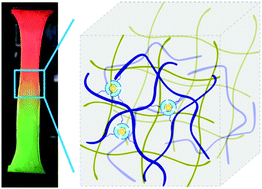Simultaneous enhancement of mechanical strength and luminescence performance in double-network supramolecular hydrogels†
Abstract
Luminescent hydrogels have been considered as one of the ideal candidates for fabrication of electro-photonic devices and development of soft functional materials due to their extraordinary optical properties and functional versatility. Herein, we report the construction of double-network luminescent supramolecular hydrogels via in situ copolymerization of acrylamide and functional monomers, which are precoordinated allyl-modified 2,6-pyridinedicarboxylic acid lanthanide complexes Ln·L3 in the presence of polyvinyl alcohol skeleton. The Ln·L3 complexes act as multifunctional conjunctions and cross-link the polyacrylamide chains, thus improving the mechanical strength of the obtained supramolecular hydrogels. As a result, extremely stretchable and tough supramolecular hydrogels with remarkable self-healing capability at room temperature are achieved. Moreover, compared to the individual Ln·L3 emitting precursor, the luminescence performance of the obtained supramolecular hydrogels is significantly improved with much longer excited lifetime and higher luminescent quantum yield, which can be ascribed to the reduced coordinated water molecules in the first coordination sphere of Ln3+ ions.

- This article is part of the themed collection: Photonics


 Please wait while we load your content...
Please wait while we load your content...